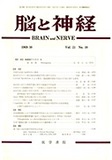Japanese
English
- 有料閲覧
- Abstract 文献概要
- 1ページ目 Look Inside
I.はじめに
頭部外傷後に自発眼振を認めるとき,その発現の原因については,かつては末梢の迷路前庭の障害が主として考えられてきたが,最近ではむしろ脳幹の障害を重視すべきであるとの傾向になつてきた。頭部外傷では,迷路はもちろん同時に脳幹を含めた中枢神経の障害が起こることは剖検でも,あるいは実験的にも証明されている1)2)。
迷路障害による自発眼振と,脳幹および小脳障害によるそれとはつねに鑑別されるとはかぎらないが,負荷検査などの種々の神経眼科および神経耳科学的検査を行なうことによつてある程度この両者を鑑別することが可能であることが多い3)4)。
This paper deals with neuro-otological observa-tions in patients with head injury, especially with the mechanism in the development of spontaneous nystagmus and its diagnostic significance.
Case Material
Case material included 1, 000 patients who visited the Department of Neurosurgery, the Kanto-Rosai Hospital, and the Toranomon Hospital from July 1966 to February 1968. Seven-hundred thirty of them were male and 270 female, the male-female ratio being 1: 0.32.
Incidence of Nystagmus
Percentage of the patients showing nystagmus among all the patients tested was compared accord-ing to the time interval between the date of injury and the first examination : less than 1 week, 20. 5% ; less than 2 weeks, 21. 8% ; less than 3 weeks, 30. 8% ; less than 6 weeks, 30. 2% ; less than 6 months, 30. 2% ; and longer than 6 momths, 41. 0%.
Site of Head Injury
The site of injury was classified as frontal, tem-poral, parietal, occipital, and unclassified. Incidence of nystagmus in each site was 24. 8%, 31. 3%, 21. 6%, 25. 8% and 21. 9% respectively. According-ly, contusion at the temporal region provoked nystagmus more frequently. The order of site with regard to incidence of nystagmus was as follows ; temporal>occipital>frontal>parietal.
Disturbance of Consciousness
In patients who had a certain period of loss of consciousness, nystagmus was observed in 35. 5%, while in patients who had fainting temporarily, it was seen in 29.4%. However, in patients who had no episode of unconsciousness, nystagmus was seen in 20.2%. The patients who had loss of conscious-ness and those who had fainting all together, 33. 8% of them manifested nystagmus.
Classification of Observed Nystagmus
The gaze nystagmus was observed in 60. 2%, the positioning nystagmus in 43. 2%, and the positional nystagmus 23. 1% respectively.
a. The gaze nystagmus
The horizontal type was seen in 74 patients (47. 1%), and the horizontal-rotatory in 79 patients (50. 3%).
b. The positioning nystagmus
The horizontal type was seen in 40 patients (31. 0%), the horizontal-rotatory in 15 (11. 6%), the rotatory in 25 (19. 4%), which included the vertical-rotatory and the vertical-oblique. Identification of these two types was found difficult : A more rotatory type among them was probably identified as the rotatory, and a more vertical as the vertical.
c. The positional nystagmus
The horizontal type was seen in 28 patients (49. 0%), the horizontal-rotatory in 11 (19. 3%), the rotatory 15 (26. 5%), and the vertical 3 (5. 3%) res-pectively.
Other Neurological Symptoms
In patients showing nystagmus, incidences of dis-turbance in sensation, body equilibrium, and hearing as well as of pathological and exaggerated tendon reflexes were investigated. The equilibrium distur-bance was found in 31. 0%, slightly exaggerated tendon reflexes in 29. 8%, the disturbance in sensa-tion on the face in 9. 6%, the hearing disturbance 15. 3%, and pathological reflexes (including Babin-ski's and Rossolimo's reflex and Wartenberg's sym-ptom) 14. 2% respectively.
Likewise, in all the patients subjected to the present study, the incidences of these neurological symptoms were investigated. The disturbance in sensation over the face was found in 42 patients, and 25 of them showed nystagmus (58. 2%). Nystag-mus was also observed in 22 out of 39 patients presenting the disturbance in peripheral sensation (56. 5%), in 78 out of 228 patients showing exag-gerated tendon reflexes (34. 2%), in 37 out of 43 patients showing pathological reflexes (86. 0%), in 81 out of 206 patients presenting the equilibrium disturbance (39. 3%), and in 40 out of 53 patients manifesting the hearing disturbance (75. 5%) res-pectively. Accordingly, the order of neurological symptoms with regard to incidence of the sponta-neous nystagmus was as follows ; pathological reflexes> hearing disturbance >disturbance in sensa-tion> equilibrium disturbance > exaggeration of ten-don reflexes.
Vertigo
Only 85 out the 1, 000 patients in this series complained of vertigo. Similarly, 24 out of the 261 patients presenting nystagmus had the episodes of vertigo. This finding indicates that coexistence ofnystagmus with vertigo is not common.
SYNOPSIS
1) Tests for the spontaneous and induced nystag-mus were carried out in 1,000 patients with head injury. Various grade of pathological nystagmus was observed in 261 of them.
2) In these patients, the presence of nystagmus was often the only positive finding.
3) The gaze nystagmus was found the most fre-quently, then the positioning nystagmus, and the positional nystagmus the least frequently.
4) The patients who complained of vertigo were much less as compared with those who showed nystagmus.
5) Clinical investigations with regard to nystag-mus or other symptoms suggested that the brain lesions due to head injury were mostly localized at a relatively upper part of the brain-stem.
I dedicate this paper to Couragious La Fu Sing, U Ching Fang, and Dr. Chang Uei Shui, Taiwan, China.

Copyright © 1969, Igaku-Shoin Ltd. All rights reserved.


